 Image search results - "site" Image search results - "site" |

Shinkyo Sacred Bridge, Nikko 神橋
|
|

Kids on school trip along Omotesando 表参道
|
|

A National Treasure and World Heritage Site, Nikko's magnificent shrines and temples overshadow any other attractions Tochigi has. The Toshogu Shrine is especially famous and also serves as Tokugawa Ieyasu's mausoleum. Omotesando 表参道
|
|

Horse stable
|
|

Horse stable
|
|

Hear, speak, and see no evilWood carving on the horse stable
|
|

Five-story pagoda 五重塔
|
|

Japan's most famous temple, with the world's oldest wooden buildings (over 1,300 years old), is also the country's first World Heritage Site. Also called Ikaruga-dera, the temple is the headquarters of the Shotoku-shu Buddhist Sect. Path to
|
|

Oriental zodiac (hare) carving on five-story pagoda
|
|

Admission charged. The 1,000 yen ticket gets you into the three major sights.
|
|
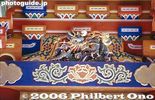
Oriental zodiac (dragon) carving on five-story pagoda
|
|

Nandaimon Gate 南大門
|
|

Oriental zodiac (tiger) carving on five-story pagoda
|
|

Horyuji temple, Nandaimon Gate, National Treasure 南大門(国宝)
|
|

Niomon
|
|

Founded in 607 by Prince Shotoku Taishi, Horyuji is one of Japan's most famous temples, with the world's oldest wooden buildings (over 1,300 years old). Japan's first World Heritage Site.
|
|
|
|

Also called Ikaruga-dera, the temple is the headquarters of the Shotoku-shu Buddhist Sect founded by Shotoku Taishi.
|
|
|

西院伽藍
|
|

Group photo
|
|
|
|

Map of Horyuji. Large complex of buildings. Only two precincts are open to the public.
|
|
|
|

Horyuji and World Heritage Site (Japan's first) marker
|
|

Dragon on ceiling that squeaks when you clap.
|
|

Sai-in Garan West Precinct 西院伽藍
|
|

Yomeimon Gate, National Treasure 陽明門
|
|

三経院 National Treasure
|
|

Yomeimon Gate, National Treasure, Nikko 陽明門
|
|

Horyuji temple Five-Story Pagoda and Kondo Hall, National Treasures 五重塔 金堂
|
|

Rear of Yomeimon Gate
|
|
|
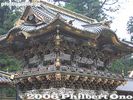
Rear of Yomeimon Gate
|
|

Five-Story Pagoda and Kondo Hall, National Treasures 五重塔 金堂
|
|

Yomeimon Gate
|
|
|

Yomeimon Gate
|
|

Goju-no-To (Five-Story Pagoda), National Treasure, Horyuji. The size of the roof gets smaller toward the top of the structure. 五重塔 仏舎利
|
|

Portable shrine storehouse
|
|

Horyuji Goju-no-To (Five-Story Pagoda) National Treasure. Houses a few bones of Shakyamuni Buddha. 五重塔
|
|

Karamon
|
|

The Five-Story pagoda has a thick wooden pillar in the center going from the bottom to the top. Only the top part of the building is in contact with the central pillar and works to counterbalance earthquake swaying.
|
|

Karamon close-up
|
|

You can enter or see inside the buildings, but no photography is allowed inside.
|
|

Sleeping cat
|
|

Daikodo Hall and Five-Story Pagoda, National Treasures 五重塔
|
|

Sleeping cat 眠り猫
|
|
|
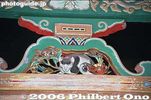
Sleeping cat 眠り猫
|
|
|
|
|
|
|
|

Tokugawa Ieyasu's mausoleum
|
|
|

Tokugawa Ieyasu's mausoleum
|
|

Horyuji temple Kondo Main Hall, the world's oldest wooden building at 1,300 years old. National Treasure 金堂
|
|

Kondo Main Hall, National Treasure and Horyuji's most important building. However, on January 26, 1949, much of the first floor was destroyed by accidental fire. 金堂
|
|

Kondo Main Hall houses 13 Buddha statues. 金堂
|
|

Kondo Main Hall, National Treasure. It has some Chinese design elements. 金堂
|
|

Kondo Main Hall, National Treasure 金堂
|
|

Kondo Main Hall, National Treasure 金堂
|
|
|
|
|

To Daikōdō Hall
|
|

Daikōdō Hall, National Treasure. Houses Buddha statues. 大講堂
|
|

Horyuji temple, Daikōdō Hall, National Treasure 大講堂
|
|

Lantern
|
|

Lantern relief
|
|

Chūmon Gate, National Treasure 中門
|
|

Chūmon Gate, National Treasure 中門
|
|

Even the corridor is a National Treasure. Has about 150 wooden pillars. 西院伽藍の廻廊
|
|

Chūmon Gate and Kondo Hall
|
|

Corridor and Chūmon Gate 西院伽藍の廻廊
|
|

National Treasure
|
|
|
|
|

Daiho-zoin Museum. Admission included in the 1,000 yen ticket. 大宝蔵院
|
|

Daiho-zoin Museum 大宝蔵院
|
|

Tōdaimon Gate, National Treasure 東大門
|
|

Path to Yumedono Pavilion
|
|

Path to Yumedono Pavilion
|
|

Path to Yumedono Pavilion
|
|

Gate to Yumedono Pavilion
|
|

Ticket gate to Yumedono. Admission included in the 1,000 yen ticket.
|
|

Yumedono Pavilion, National Treasure dedicated to Shotoku Taishi. Built on the site of Prince Shotoku's palace. 夢殿
|
|

Horyuji temple, Yumedono Pavilion, National Treasure. The Nippon Budokan martial arts hall in Tokyo was designed after this pavilion. 夢殿
|
|

Hall of Paintings has the Illustrated Biography of Prince Shōtoku (National Treasure), masterpiece 11th century wall painting depicting Shotoku Taishi's life episodes bordering on legend and myth since he was later revered as a Buddha by Horyuji. �
|
|

Hall of Paintings. The original painting is preserved at Tokyo National Museum. Official video of the painting: https://youtu.be/sJB-03HQMNA 国宝 聖徳太子絵伝 絵殿、舎利殿
|
|

Bell tower in East Precinct 東院鐘楼
|
|

Bell tower in East Precinct 東院鐘楼
|
|

東院鐘楼
|
|

Signs to other temples
|
|

Hiraizumi in Iwate Prefecture was designated as a World Heritage Site in 2011, announced soon after the March 11, 2011 Tohoku disaster.
|
|

Hiraizumi's two main attractions are Chusonji temple (famous for Konjikido Hall covered with gold leaf) and Motsuji temple's garden.
|
|

The temples of Hiraizumi are near JR Hiraizumi Station on the Tohoku Line. Hiraizumi is a short train ride from Ichinoseki Station, a shinkansen station.
|
|

Once you arrive at Hiraizumi, the best way to get around is by bicycle. There are a few bicycle rental places near the station. Mail box at Hiraizumi Station.
|
|

When I arrived on May 2, 2012, this dance troupe danced in front of Hiraizumi Station. The train station has a nice tourist information office where you can pick up maps and pamphlets and directions to bicycle rentals.
|
|

They were so good that I delayed my departure from the train station to watch this.
|
|
|
|
|

I parked my rental bicycle near this entrance to Chusonji temple grounds.
|
|

Entrance to the grounds of Chusonji temple. Chusonji belongs to the Tendai Buddhist sect and was founded in 850 by Ennin, a high-ranking priest of Enryakuji Temple on Mt. Hiei in Shiga Prefecture.
|
|

Chusonji is the Tohoku headquarters temple for the Tendai Buddhist sect. About 800 meters to Konjikido Hall.
|
|

Jizo statue and Chusonji stone sign.
|
|

A slight sloping path going to Chusonji temple. It's a nice wooded path.
|
|

Chusonji was first built in the early twelfth century by the first Ōshū Fujiwara lord, Kiyohira. It became a huge temple complex, but most structures were destroyed by fire in 1337. The famous Golden Hall remains.
|
|
|

Along the way was this Benkei Hall and a fallen torii.
|
|

The 3/11 earthquake fell this torii at Benkei Hall.
|
|
|

Benkei Hall.
|
|

Benkei Hall at Chusonji temple, Hiraizumi.
|
|

Inside Benkei Hall.
|
|

Statue of Benkei in the corner.
|
|
|

Statues inside Benkei-do Hall at Chusonji temple, Hiraizumi.
|
|

About Benkei Hall.
|
|

Eastern Lookout deck along the way to Chusonji.
|
|

From the lookout point are a few cherry blossoms.
|
|
|
|

Continuing on the path to Chusonji's Hondo main hall. The main path to Chūson-ji is called Tsukimizaka (Moon Viewing Slope). It is lined with cryptomeria trees planted three or four centuries ago by the Date clan of Sendai.
|
|
|

Another scenic lookout point.
|
|
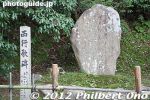
Poem monument for Saigyo (1118-1190), a famous Japanese poet who traveled in the Tohoku area a lot.
|
|
|

Cherry blossoms at a scenic lookout deck.
|
|
|

Gate to Chusonji's Hondo main hall.
|
|

Chusonji's Hondo main hall in Hiraizumi. It was last rebuilt in 1909. Its main object of worship is Amida Nyorai (the Buddha of Infinite Light), flanked by Chūsonji's eternal flames which came from Enryakuji in Shiga Prefecture.
|
|

Incense burner in front of Chusonji's Hondo main hall.
|
|

Placing incense into the incense burner in front of Chusonji's Hondo main hall.
|
|

Water fountain
|
|

Chusonji's Hondo main hall, Hiraizumi, Iwate Prefecture.
|
|
|
|

The paper lantern at the entrance of Chusonji's main hall says that it is Tendai Sect's Tohoku Headquarters Temple (Tohoku Dai-honzan).
|
|

Altar inside Chusonji's Hondo main hall.
|
|
|

Cherry tree near Chusonji's Hondo main hall.
|
|

Chusonji's temple bell.
|
|

On to Konjikido, 240 meters away.
|
|

Fudo-do Hall, a prayer training hall. Worships Fudo-myoo. 不動堂
|
|

Mine-yakushido Hall. Chusonji has a number of smaller halls of worship. 峯薬師堂
|
|

Mine-yakushido Hall worships Yakushi Nyorai. 峯薬師堂
|
|

Bonsho temple bell at Chusonji temple. Nice building for the bell. 梵鐘
|
|

About the Bonsho temple bell at Chusonji temple. 梵鐘
|
|

Benzaiten-do Hall 辨財天堂 辨財天十五童子
|
|

Benzaiten-do Hall worships the 15 male attendants (jugo-doji) who serve the Ugajin deity associated with the goddess Benzaiten. 辨財天堂 辨財天十五童子
|
|

Benzaiten-do Hall 辨財天堂
|
|

About the Benzaiten-do Hall.
|
|
|

Chusonji's fire dept.
|
|

Up to this point, visiting Chusonji is free. But when you want to see the Konjikido Golden Hall (National Treasure), that's when you have to pay admission.
|
|

To see the Konjikido Hall, pay admission here at the Sankozo Museum. Admission includes entry to the Golden Hall as well as to Sankozo Museum filled with Chūson-ji's various treasures and cultural objects.
|
|

Konjikido Golden Hall admission is 800 yen for adults, 500 yen for high schoolers, 300 yen for junior high schoolers, and 200 yen for elementary school kids.
|
|

The admission fee includes admission to Konjikido Hall, Sankozo Museum, Sutra Repository, and the Former Konjikidō Shelter Hall.
|
|

Path to Konjikido Hall, the main attraction of Chusonji temple. 金色堂
|
|

This is the Konjikido Hall building you always see in tourist literature. Doesn't look so impressive as a National Treasure. What you see is only the protective housing for the actual Konjikido Golden Hall sheltered inside.
|
|

According to an ancient Buddhist prophecy, the world would enter a period of decline called Mappō in 1051. The Tendai sect believed that enlightenment was possible during Mappo only through the veneration of Amida Buddha.
|
|
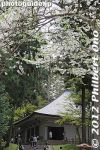
Consequently, the Golden Hall at Chūson-ji was built by the Fujiwara Family to recreate the western paradise of Amida on earth.
|
|

Photography of the Konjikido is not allowed, but you can see photos of it at Chusonji's Web site here.. Konjikido is fenced off.
|
|

Ticket gate to enter Konjikido Golden Hall.
|
|

The Konjikido is inside this building sheltering it. They let you into the building one group at a time. There's a short recorded talk about the Konjikido, then you are ushered out of the building to make room for the next group.
|
|

The Golden Hall is indeed gold and beautiful. It's not that big and looks brand new, thanks to restoration work. The gold leaf gleams and shell inlays in the columns are intricate.
|
|
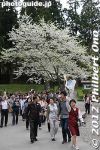
I went during Golden Week so there was a good number of people, but it wasn't horrendously crowded.
|
|

Monument for haiku poet Basho.
|
|

Near the Konjikido is the Kyozo Sutra Repository. 経蔵
|
|

Kyozo Sutra Repository. Important Cultural Property. 経蔵
|
|
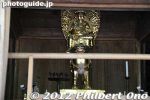
Kyozo Sutra Repository. 経蔵
|
|

About the Kyozo Sutra Repository.
|
|

Roots
|
|

Haiku poet Basho Monument for his Oku-no-Hosomichi series.
|
|

Statue of Haiku poet Basho at Chusonji temple.
|
|

Former housing for the Konjikido Golden Hall, called Konjikido Oido. This building sheltered the Konjikido from 旧覆堂
|
|

About the old housing for the Konjikido Golden Hall, called Konjikido Oido. 旧覆堂
|
|
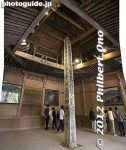
Inside the former housing for the Konjikido Golden Hall, called Konjikido Oido. The Konjikido was housed here until 1963 when the present housing was built. 旧覆堂
|
|

Path to Hakusan Shrine.
|
|

Chusonji votive tablets.
|
|

While walking back and passing by the Hondo main hall, I found this group dancing in front of the Hondo hall.
|
|

Taiko drum dance by eight men dressed as fierce-looking deer-lion with tall antlers and a mane.
|
|

The dance is called Gyozan-ryu Tsunogake Shishi Odori or Gyozan School Antlered Deer Dance. They sing in Buddhist tones. They perform here annually on May 2.
|
|
|
|
|
|
|
|
|
|
|
|
|
|
|
|
|

Great dance. Enjoyed it very much. Be sure to see my video.
|
|

My video of the antlered deer dancers at Chusonji.
|
|

Rental bicycles near Chusonji.
|
|

Motsuji temple is part of the "Historic Monuments and Sites of Hiraizumi" World Heritage Site. It belongs to the Tendai Buddhist sect. This is the gate to enter Motsuji temple.
|
|

Motsuji was founded in 850 by Ennin, the third abbot of Tendai based at Enryakuji temple atop Mt. Hiei in Shiga Prefecture. This is their museum called Cultural Assets Repository.
|
|

Since most of the temple structures burnt down, the main attraction today is the 800-year-old Pure Land Garden featuring a large pond called Oizumi ga Ike.
|
|

English translation of a Haiku poem by Basho, in reference to the temple buildings that were long gone when he visited.
|
|

About the haiku poem by Basho.
|
|

Haiku poet Basho monument
|
|
|

What Motsu-ji temple looked like before.
|
|

Weeping cherries and Motsuji's Hondo hall in Hiraizumi, Iwate Prefecture.
|
|

Motsuji's Hondo main hall was built in 1989.
|
|

Motsuji's Hondo main hall was built in 1989.
|
|

Incense burner
|
|

Motsu-ji's Hondo main hall.
|
|

About Motsuji's Hondo main hall. Nice to see English explanations.
|
|

Inside Motsuji's Hondo main hall. It worships Yakushi, flanked by two Boddhisatvas, Nikko ("Daylight") and Gakko ("Moonlight").
|
|
|
|
|

After you see the Hondo main hall, you basically walk around the garden's Oizumi ga Ike pond while seeing former temple sites and smaller buildings.
|
|

The garden has been restored to its original condition.
|
|
|
|
|
|

About mountain-like formations.
|
|
|
|

Irises donated by Meiji Jingu Shrine in Tokyo.
|
|

Oizumi ga Ike pond at Motsuji temple, in Hiraizumi, Iwate Prefecture. World Heritage Site.
|
|

Kaisando is the Founder's Hall dedicated to Priest Ennin. 開山堂
|
|

About Kaisando, the Founder's Hall dedicated to Priest Ennin.
|
|

Inside Kaisando, the Founder's Hall dedicated to Priest Ennin.
|
|

Oizumi ga Ike pond at Motsuji temple, in Hiraizumi, Iwate Prefecture. World Heritage Site.
|
|
|

Site of Kashoji temple at Motsuji, Hiraizumi. 嘉祥寺
|
|

Site of Kashoji temple at Motsuji, Hiraizumi. 嘉祥寺
|
|

Site of Kashoji temple at Motsuji, Hiraizumi. 嘉祥寺
|
|

Site of Enryuji temple's Kondo hall at Motsuji, Hiraizumi. 圓隆寺
|
|

Site of Enryuji temple's Kondo hall at Motsuji, Hiraizumi. It's depressing to keep seeing these empty plots which used to have magnificent temple structures. 圓隆寺
|
|

Yarimizu stream feeding water to the pond.
|
|

Yarimizu stream feeding water to the pond.
|
|

Yarimizu stream feeding water to the pond.
|
|

About the Yarimizu stream feeding water to the pond.
|
|

Site of the temple bell or befry.
|
|
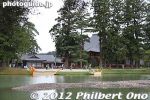
Motsuji's Hondo hall on the right as seen from across the pond.
|
|

Jizo Bosatsu statue.
|
|

About the Jizo Bosatsu statue.
|
|

Jogyodo
|
|

Jogyodo Hall, this building was built in 1732.
|
|

Jogyodo Hall, Motsuji temple, Hiraizumi.
|
|

About Jogyodo Hall.
|
|

Jogyodo Hall worships Amida Buddha.
|
|
|
|
|
|